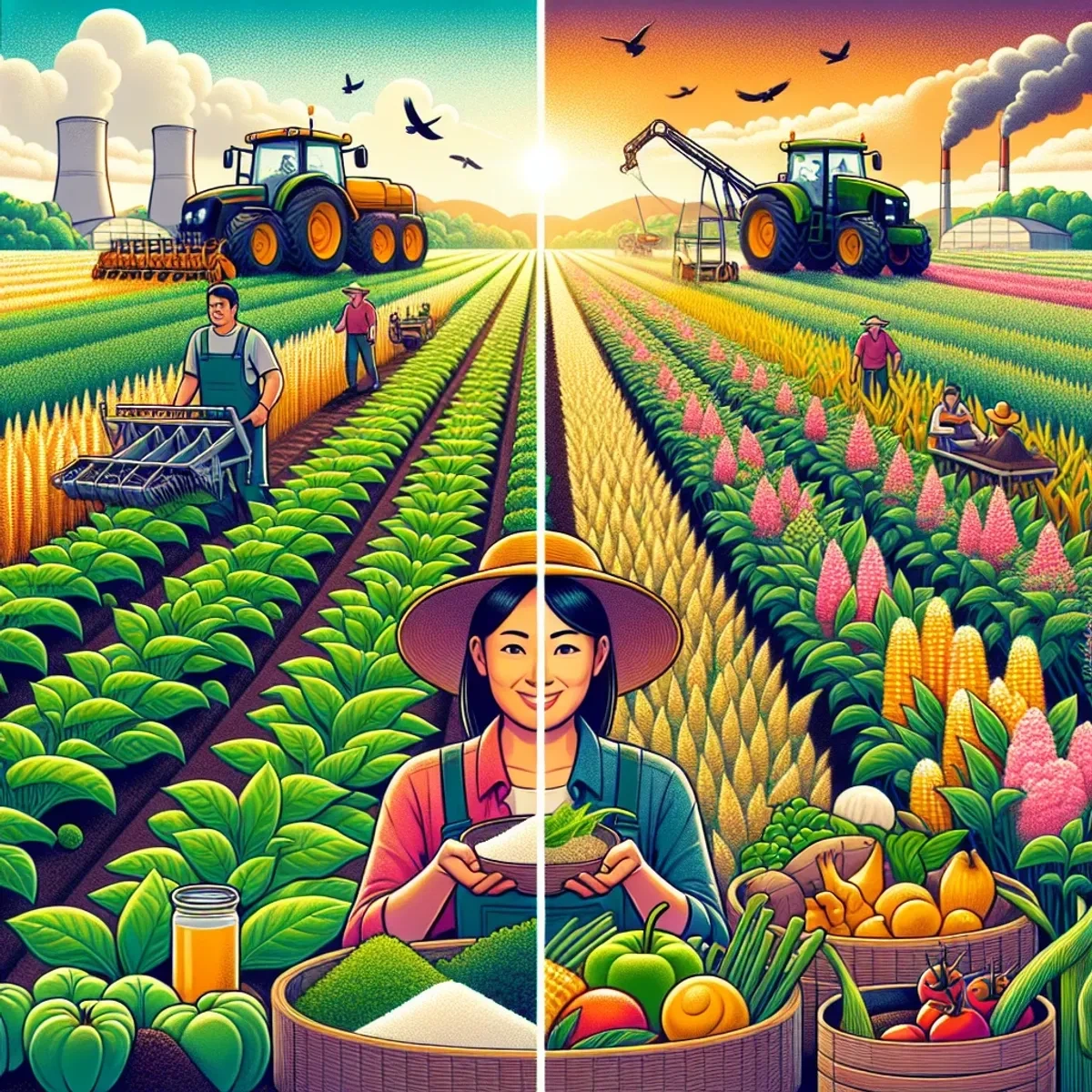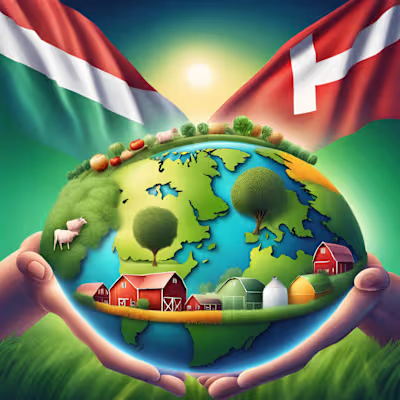Chemical Usage Comparison
Chemical Usage Comparison

Understanding Chemical Usage in Farming: A Comparison Between Conventional and Organic Methods
Chemical usage in farming practices plays a crucial role in determining the sustainability and environmental impact of agricultural systems. As consumers, understanding the differences between conventional and organic methods of farming can help us make informed choices that support our health and the well-being of the planet.
The Importance of Sustainable Agriculture
The importance of sustainable agriculture cannot be overstated. With a growing global population and increasing demand for food, it is essential to adopt farming practices that minimize harm to the environment and prioritize human health.
Chemicals used in farming, such as pesticides, herbicides, and synthetic fertilizers, have both positive and negative impacts on crop production and ecosystem health.
Comparing Conventional and Organic Farming
By comparing the chemical usages of conventional and organic farming, we can gain valuable insights into their respective impacts on the environment and human health. This comparison allows us to evaluate:
The sustainability of different farming methods
The potential effects on human health
Ultimately, this knowledge empowers us to support sustainable agriculture for a healthier future.
Key Takeaway: Understanding chemical usage in farming is crucial for making informed choices as consumers. By comparing conventional and organic farming practices, we can assess their environmental impact and potential effects on human health.
Conventional Farming: The Heavy Reliance on Chemicals
Conventional farming is the main method of agriculture that heavily depends on synthetic chemicals to maximize crop yields. This approach involves using pesticides, herbicides, and synthetic fertilizers to control pests, weeds, and provide essential nutrients to plants. Conventional farming is characterized by large-scale monoculture farming, mechanization, and a focus on high productivity.
Commonly Used Chemicals in Conventional Farming
Here are the most commonly used chemicals in conventional farming:
Pesticides: These chemical compounds are used to control insects, fungi, and other pests that can damage crops. Examples of commonly used pesticides include organophosphates, pyrethroids, and neonicotinoids.
Herbicides: Herbicides are used to eliminate unwanted weeds that compete with crops for resources such as water, sunlight, and nutrients. Glyphosate (commonly known as Roundup) is one of the most widely used herbicides in conventional farming.
Synthetic Fertilizers: Synthetic fertilizers provide essential nutrients such as nitrogen, phosphorus, and potassium to enhance plant growth. These fertilizers are typically derived from non-renewable resources like natural gas and petroleum.
Environmental Impact of Chemical Usage in Conventional Farming
The heavy reliance on chemicals in conventional farming has significant environmental consequences:
Soil Degradation: Continuous use of synthetic fertilizers can lead to soil degradation by depleting organic matter and beneficial microorganisms. This results in reduced soil fertility and nutrient retention capacity.
Water Pollution: Chemical runoff from fields can contaminate nearby water bodies through surface runoff or leaching into groundwater. Pesticides and synthetic fertilizers contribute to water pollution, affecting aquatic ecosystems and potentially contaminating drinking water sources.
Harm to Beneficial Organisms: Pesticides intended for pest control may harm beneficial organisms like bees, birds, butterflies, and other pollinators. These organisms play a vital role in maintaining biodiversity and supporting ecosystem services.
Transitioning Towards Sustainable Alternatives
The environmental impact of chemical usage in conventional farming has led to a growing demand for sustainable alternatives like organic farming. Organic farming emphasizes the use of natural inputs and ecological practices to minimize reliance on synthetic chemicals. By adopting methods such as:
Crop rotation
Composting
Cover cropping
Natural pest control measures like biological controls or companion planting
Organic farmers aim to build healthy soils while reducing chemical inputs.
In the next section, we will delve into organic farming practices and compare the chemical usages between conventional and organic methods.
The Growing Demand for Organic Farming: A Safer Alternative
Organic farming has become increasingly popular in recent years because it focuses on sustainability and avoids synthetic chemicals. This method works with nature instead of against it, which promotes soil health, biodiversity, and the overall well-being of ecosystems. By learning about organic farming principles and practices, consumers can make informed choices that align with their values and support a safer alternative to traditional agriculture.
Definition and Principles of Organic Farming
Organic farming is an agricultural approach that prioritizes natural inputs and techniques while avoiding synthetic chemicals. Its goal is to create a closed-loop system that replenishes and sustains the soil, encourages biodiversity, and reduces environmental impact. Here are some key principles of organic farming:
No synthetic chemicals: Organic farmers cannot use synthetic pesticides, herbicides, or fertilizers. Instead, they rely on natural alternatives to manage pests, weeds, and nutrient needs.
Soil health: Organic farming places a strong emphasis on building and maintaining healthy soil through practices like composting, crop rotation, cover cropping, and minimal tillage. These methods improve soil structure, fertility, and microbial activity.
Biodiversity: Organic farms encourage biodiversity by providing habitats for beneficial organisms such as pollinators, birds, insects, and microorganisms. This helps maintain ecological balance and reduces the need for chemical interventions.
Animal welfare: Organic farming standards also extend to animal welfare by prohibiting the routine use of antibiotics and growth hormones in livestock production.
Restrictions on Chemical Usage in Organic Farming Certifications
To ensure transparency and consumer trust, organic farming certifications like USDA Organic have strict guidelines regarding chemical usage. Here are some key restrictions:
Prohibited substances: Synthetic pesticides, herbicides, fungicides, and genetically modified organisms (GMOs) are not allowed in organic farming.
Approved substances: Certain naturally derived substances like copper sulfate or botanical extracts may be permitted if they meet specific criteria for safety and environmental impact.
Buffer zones: Organic farms must have buffer zones to reduce the risk of contamination from nearby conventional farms or sources of chemical pollutants.
Alternative Practices in Organic Farming
Organic farmers use a variety of alternative practices to reduce their reliance on chemicals while managing pests, weeds, and nutrient needs sustainably. Here are some common techniques:
Crop rotation: Rotating crops helps disrupt pest life cycles by changing their habitat. Different crops also have different nutrient requirements, which reduces soil depletion.
Composting: Organic farmers make and use compost from plant materials or animal manure to naturally enrich soil fertility. Compost improves soil structure and provides essential nutrients for plant growth.
Natural pest control methods: Organic farmers implement various biological controls like beneficial insects (e.g., ladybugs), birds (e.g., barn owls), trap crops (plants that attract pests away from cash crops), or insect-repelling companion plants.
By adopting these alternative practices, organic farming decreases chemical inputs while promoting ecological balance and sustainable agriculture.
Comparing Chemical Usages: Conventional vs. Organic Farming
When it comes to chemical usage in farming, a stark contrast can be observed between conventional and organic methods. Understanding the differences between these two approaches can shed light on their impact on soil health, biodiversity, and overall environmental sustainability.
Side-by-Side Analysis of Chemical Usage
In conventional farming, the heavy reliance on chemicals is evident. Pesticides, herbicides, and synthetic fertilizers are commonly used to control pests, weeds, and enhance crop yields. These chemicals are often applied in large quantities to ensure maximum efficacy. On the other hand, organic farming strictly limits the use of synthetic chemicals and opts for natural alternatives.
While specific data may vary depending on factors such as location and farming practices, studies have shown notable differences in chemical usage between conventional and organic farming:
Pesticides: Conventional farming relies heavily on pesticides to combat pests that can damage crops. Synthetic pesticides are used extensively to control insects, fungi, and other harmful organisms. In contrast, organic farming utilizes natural pest control methods such as biological controls (introducing beneficial insects), crop rotation, and companion planting.
Herbicides: Conventional farming employs herbicides to suppress weed growth that competes with crops for nutrients and resources. These herbicides are often non-selective and can negatively impact biodiversity by harming beneficial plants and organisms. Organic farmers rely on techniques like manual weeding, mulching, and cover cropping to manage weeds without the use of synthetic herbicides.
Fertilizers: Synthetic fertilizers are commonly used in conventional farming to provide essential nutrients for plant growth. These fertilizers are usually formulated with high concentrations of nitrogen, phosphorus, and potassium (NPK). Organic farmers focus on building soil fertility through practices such as composting, crop rotation, and the use of organic amendments like manure or plant-based materials.
Impact on Soil Health and Biodiversity
The contrasting chemical usage in conventional and organic farming has significant implications for soil health and biodiversity:
Soil Health: The excessive use of synthetic chemicals in conventional farming can lead to soil degradation over time. Continuous application of pesticides and synthetic fertilizers can disrupt soil microbial communities, reducing their diversity and overall function. In contrast, organic farming practices promote soil health by improving its structure, enhancing nutrient cycling, and fostering a more diverse microbial community.
Biodiversity: Chemicals used in conventional farming can have adverse effects on biodiversity. Pesticides designed to eliminate pests may also harm beneficial organisms such as bees, birds, earthworms, and other pollinators or natural predators that help maintain ecological balance. Organic farming's emphasis on natural pest control methods helps preserve biodiversity by providing habitats for beneficial organisms.
By comparing the chemical usages of conventional and organic farming methods side by side, it becomes evident that organic farming offers a safer alternative with reduced reliance on synthetic chemicals. Organic practices prioritize long-term sustainability by promoting soil health and preserving biodiversity.
The Risks of Excessive Chemical Usage in Conventional Farming
Excessive chemical usage in conventional farming can have several negative consequences. These risks occur when chemicals are used too much or in the wrong way, and they can harm both the environment and human health.
Pesticide Resistance
One significant risk is the development of pesticide resistance. When pesticides are used a lot, pests can change their genes to become resistant to the chemicals. This means that higher amounts or different types of pesticides may be needed to control them, which leads to using even more chemicals. Pesticide resistance not only makes pest control less effective but also reduces the number of natural predators that keep pests in check, which can harm other plants and animals.
Groundwater Contamination
Another risk linked to excessive chemical usage is groundwater contamination. Chemicals applied on crops can go into the soil and eventually reach underground water sources through seeping or running off. This contamination is dangerous for drinking water supplies and can have long-lasting effects on ecosystems.
Nutrient Imbalances
Moreover, conventional farming often depends on man-made fertilizers, which can create problems with the balance of nutrients in the soil. Using too much fertilizer can make nutrients wash away into nearby bodies of water, causing too much algae to grow and using up oxygen, known as eutrophication. This harms water-dwelling ecosystems and can kill fish.
Human Health Effects
Additionally, the use of chemical pesticides and herbicides in conventional farming has been associated with negative effects on human health. Being exposed to these chemicals by eating contaminated food or through work for farmers and farm workers has been linked to different health problems, including trouble breathing, disruption of hormones, and higher chances of certain types of cancer.
In summary, excessive chemical usage in conventional farming brings risks like pesticide resistance, groundwater contamination, nutrient imbalances, hurting the environment, and possibly harming people's health. These risks show why we need sustainable options like organic farming methods that use as few chemicals as possible.
Visualizing the Difference: Infographics for Chemical Usage Comparison
When it comes to understanding complex data like chemical usage in farming, visual representations can be extremely helpful. Infographics and side-by-side comparisons provide a clear and concise way to illustrate the stark contrast between conventional and organic farming practices. Here are some key points to consider when creating effective infographics for chemical usage comparison:
Importance of visual representations
Visuals have a powerful impact on our ability to comprehend information quickly and retain it better. By using infographics, we can simplify complex data and make it more accessible to a wider audience.
Highlighting the differences
The main goal of these infographics is to highlight the significant differences in chemical usage between conventional and organic farming. This can include aspects such as the types of chemicals used, quantities applied, and the overall impact on the environment.
Clear comparison
It's crucial to ensure that the infographic clearly presents a side-by-side comparison of conventional and organic farming practices. This can be achieved through visual elements such as color-coding, arrows, or icons to represent different aspects of chemical usage.
Use of statistics
Incorporating relevant statistics into the infographic helps to reinforce the message and provide factual evidence. For example, you could include data on the amount of synthetic pesticides used in conventional farming compared to organic alternatives.
Visualizing environmental impact
Another important aspect to consider is showcasing the environmental impact of chemical usage in both farming methods. This can include visuals depicting soil degradation, water pollution, and harm to beneficial organisms like bees and birds.
Simplicity and clarity
Infographics should be visually appealing yet simple enough for viewers to understand at a glance. Avoid overcrowding with excessive text or intricate designs that may confuse or overwhelm readers.
By utilizing these guidelines, we can create infographics that effectively communicate the stark contrast between conventional and organic farming practices in terms of chemical usage. These visual representations not only help consumers make informed choices but also contribute to raising awareness about sustainable agriculture practices for a healthier future.
Remember, understanding the impact of chemical usage is just one aspect of making informed choices as consumers.
Making Informed Choices for a Sustainable Future
As consumers, we have the power to support sustainable agriculture and make a positive impact on the environment and our own well-being. By opting for organic products whenever possible, we can reduce our reliance on chemicals in food production and contribute to a more sustainable future.
Here are some key points to consider:
1. Supporting sustainable agriculture
Choosing organic products supports farmers who prioritize environmentally friendly practices and helps promote a healthier ecosystem.
2. Reducing chemical dependency
By opting for organic foods, we can reduce our exposure to potentially harmful chemicals used in conventional farming. This not only benefits our own health but also helps protect the environment from pollution and degradation.
3. Preserving long-term environmental health
By reducing chemical usage in food production, we can help preserve soil health, maintain biodiversity, and protect natural resources like water sources.
Making informed choices about the food we consume is crucial for promoting sustainability in agriculture. By supporting organic farming practices and reducing our reliance on chemicals, we can contribute to a healthier planet and ensure the well-being of future generations.
Like this project
Posted Dec 26, 2023
This Article I wrote for My Own Blog Page.
Likes
0
Views
35




